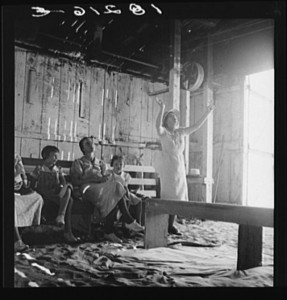The past two decades have witnessed the publication of several fine studies of religion and material culture. Thanks to the work of David Morgan, Sally Promey, and Colleen McDannell, we know a lot more about the place of visual piety in American religion.
Many of these scholars have drawn upon the work of documentary photographers, including Dorothea Lange and Walker Evans. Employed by the Farm Security Administration during Franklin Roosevelt’s New Deal, their images are now inseparable from the way that Americans remember the Great Depression.
 In Picturing Faith, McDannell critiques these photographers for their selective portraits of religious Americans. While acknowledging Dorothea Lange’s pictures of Pentecostal migrants, she writes that “Lange ignored . . . the enthusiastic worship style of poor agricultural workers,” arguing that religion “entered her photographic field of vision only for brief moments and only when it served to support her perspective.” Although Lange’s “Revival Mother” offers a rare glimpse of worship among the Dust Bowl migrants, it is only part of the story. The companion to the iconic “Migrant Mother,” it is a relatively sanitized picture of revivalistic religion.
In Picturing Faith, McDannell critiques these photographers for their selective portraits of religious Americans. While acknowledging Dorothea Lange’s pictures of Pentecostal migrants, she writes that “Lange ignored . . . the enthusiastic worship style of poor agricultural workers,” arguing that religion “entered her photographic field of vision only for brief moments and only when it served to support her perspective.” Although Lange’s “Revival Mother” offers a rare glimpse of worship among the Dust Bowl migrants, it is only part of the story. The companion to the iconic “Migrant Mother,” it is a relatively sanitized picture of revivalistic religion.
Over sixty years later, an innovative exhibition provides what Lange and Evans failed to give us: a detailed portrait of the religious lives of America’s marginalized and dispossessed. In “Golden States of Grace: Prayers of the Disinherited,” photographer Rick Nahmias presents images from eleven California communities, including Zen Buddhist inmates at San Quentin, Pentecostals in the Central Valley, deaf Mormons in San Diego, and recovering Jewish addicts in Los Angeles. After a 2006 stay at the Fullerton Museum Center, it has traveled to destinations across the Golden State. Local congregations, seminaries, and colleges and universities have hosted the exhibit, which runs through at least 2013.
An earlier exhibit by Nahmias explored the lives of migrant farm workers. Hailed for its “brilliant sense of composition” and avoidance of clichés, it addresses the same topic as “Migrant Mother.” Yet according to the Los Angeles Times, Nahmias “deliberately avoided the ‘iconic imagery’ in such work by photographers Dorothea Lange and Horace Bristol.”
Published in two volumes, Nahmias’ work will be useful for scholars of religion and material culture. As Loyola Marymount University scholar Amir Hussain wrote in the journal Material Religion, “we owe him a debt.”












